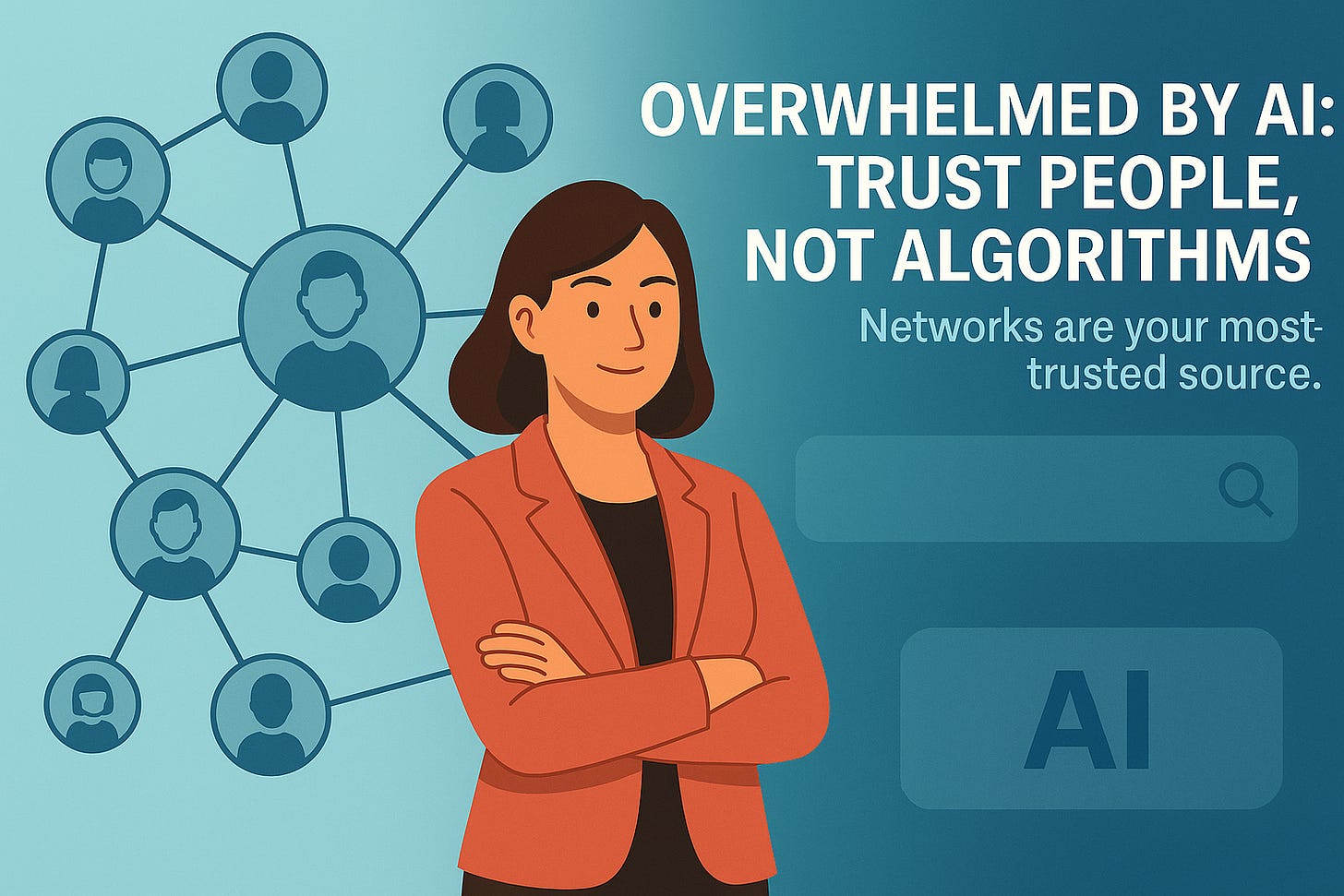Overwhelmed by AI? Make Human Networks Your Antidote
Professionals feel swamped by the pace of AI change. Networking with humans is the most trusted source, LinkedIn says.
Publisher’s note: I’ve been giving a lot of thought to the best way to position this newsletter in relation to the evolution of thinking about the topic of AI Technostress. With that in mind, I shortened the newsletter title to AI Workplace Wellness. A minor name change, but bigger in terms of how I approach the topic. ~ Paul Chaney
Professionals feel swamped by the pace of AI change, and they don’t turn to search boxes or chatbots first when they need clarity. They turn to people. New LinkedIn research finds a professional’s network is now the most-trusted source of information, even as many workers say simply “learning AI” feels like a second job.
TL;DR
LinkedIn reports that professionals are overwhelmed by the speed of AI and change, with 51% saying that learning AI feels like another job.
Trust is consolidating in networks, not algorithms: your employees and buyers rely on people they know more than on AI or search engines.
Organizations should reduce tool sprawl, build “network-first” learning, allocate protected learning time, and normalize no-shame AI conversations to prevent technostress and accelerate healthy adoption.
What LinkedIn’s Data Says (and why it matters)
Networks outrank search and AI in terms of trust. LinkedIn’s latest company research says a professional’s network is the #1 trusted source amid information overload. For B2B leaders, this extends to buying behavior: 77% say audiences don’t just vet brands via official channels—they consult their networks. Translation: peers, colleagues, and creators carry outsized credibility in noisy markets.
AI learning equals a second job. Fifty-one percent of professionals say learning AI feels like another job; LinkedIn also notes an 82% increase in posts about feeling overwhelmed and navigating change this year. That perceived “second shift” creates a chronic time/attention tax that fuels technostress and slows real adoption.
Shame and silence are blocking progress. One-third (33%) of professionals admit feeling embarrassed by how little they understand AI, and 35% say they’re nervous talking about it at work for fear of sounding uninformed. That’s a psychological safety problem, not just a skills problem.
The strain is impacting wellbeing. Coverage of the same LinkedIn research highlights that 41% feel the pace of AI change is affecting their wellbeing, with Gen Z more likely than Gen X to overstate AI skills—classic signals of performance pressure in ambiguous times.
This isn’t new—it’s compounding. LinkedIn’s 2024 data already showed 64% of professionals felt overwhelmed by the rapid pace of workplace change; top challenges included using AI at work. Today’s AI acceleration is building upon that baseline.
Implication: The “AI productivity promise” collides with a human reality: attention is finite, trust is social, and fear of looking uninformed pushes learning underground. If you want ethical, effective AI adoption, you have to manage the human system—not just deploy the tools.
🌟 Helping Teams Thrive in an AI-Driven Workplace 🌟
Technology is evolving fast, but people need time, tools, and support to keep up. The AI Technostress Institute offers training and certification programs that empower leaders, HR teams, and employees to thrive in AI-integrated workplaces. Click to see how we can help you.»
A Practical Playbook to Prevent (and Relieve) AI Technostress
Use these steps to transform the research into operational results within 90 days. They’re designed to cut overwhelm, increase psychological safety, and build skill—without adding a second job.
1. Make learning part of the job (not after-hours homework)
Block 2–4 hours per month of protected time for AI upskilling in every knowledge role. Treat it like compliance training or security drills—on the calendar, visible, and supported by managers. Bonus: rotate themes (prompting, summarization, data hygiene, meeting workflows) so the time has a clear focus. This directly addresses the “AI feels like another job” sentiment.
2. Stand up “network-first” learning loops
Because employees trust people, not platforms, formalize:
Communities of Practice (CoPs): cross-functional, opt-in groups that share AI use cases weekly.
Pairing & shadowing: match a novice with an “AI steward” for 30 days.
Ask-a-Human channels: an internal chat space where vetted practitioners answer questions within 24 hours.
These structures harness the trust advantage of networks to reduce confusion and speed diffusion.
3. Normalize no-shame AI conversations
Give managers simple scripts for 1:1s: “What’s one task AI could make easier this week?” and “Where does AI feel confusing or risky?” Publish a “No Bad Questions” policy and require leaders to model it: this counters embarrassment and fear of speaking up.
4. Win back time with targeted relief pilots
Pick 2–3 high-friction workflows (meeting notes → action items, first-draft emails, research summaries). Run 30-day pilots with clear metrics: minutes saved, error rate, employee effort, and stress level (self-reported). Share the before/after internally to make progress visible and contagious.
5. Reduce tool sprawl; go deep on fewer platforms
Audit your tech stack and retire duplicative tools. Overchoice amplifies overwhelm, especially for younger workers, who report feeling tool overload. Provide a simple “if/then” routing map so people know which tool to use in each scenario.
6. Publish role-specific AI charters & guardrails
Clarify what’s encouraged, optional, or prohibited by role (e.g., clinicians vs. marketers), including data sensitivity, review steps, and disclosure norms. This replaces guesswork with shared standards, reducing anxiety about “doing it wrong.”
7. Add a monthly Technostress Pulse
A 5-question micro-survey captures perceptions of: perceived workload, clarity of expectations, confidence in using AI, sense of control over tools, and psychological safety. Tag by team and tool. Close the loop: share what you heard and what will change next month.
8. Teach the “AI stack” in plain language
Offer a 60-minute, jargon-free briefing on how your approved tools actually work (inputs, outputs, limits, privacy). Demystification reduces cognitive load—and in turn, stress—by setting accurate expectations.
9. Create visible pathways from beginner → confident
Publish a Skills Ladder per function (e.g., Level 1: prompt basics; Level 2: workflow templates; Level 3: quality evaluation; Level 4: governance contributor). Recognize progress publicly (badges, shout-outs), which improves motivation and reduces the stigma of “not knowing yet.”
10. Leverage external networks as accelerants
Invite trusted creators, customers, and partners for short “How we actually use AI” sessions. Encourage employees to cultivate a small circle of outside mentors. This mirrors how buyers already vet brands through word of mouth, which makes learning stickier.
For Go-to-Market Teams: Align with How Trust Works Now
If 77% of B2B leaders say audiences rely on networks to vet brands, your enablement and content strategy should:
Empower credible voices: Elevate practitioners and customer champions on LinkedIn with practical demos and teardown posts.
Equip employees as guides: Provide safe-to-share templates, talking points, and disclosure guidelines so staff can advocate without legal risk.
Measure network lift: Track opportunities influenced by employee or customer posts—not just branded channels—to reflect how trust actually forms today.
Leading Indicators You’re Getting This Right
The calendar shows recurring, protected AI learning blocks across teams.
CoPs are active, answering questions promptly and sharing wins every week.
Pulse scores trend up for clarity, confidence, and control; sick days and attrition stabilize.
Fewer tools; deeper usage.
Managers can articulate role-specific guardrails without calling Legal.
More employees post thoughtful, real-world use cases—because they’re confident, not performative.
The Mindset Shift
You don’t beat technostress with more tools. You beat it by reducing friction, increasing clarity, and moving learning into trusted human networks. Make AI a feature of the workday, not a nighttime side hustle; make questions safe; make progress visible. If you do, you’ll convert anxiety into momentum—and your people will become the most trusted channel you have.
Need help implementing these strategies? The AI Technostress Institute is your answer. Contact us to learn more.
Sources: LinkedIn Corporate Communications, “Networks, Not AI or Search, Are the #1 Trusted Source Amid Information Overload” (Aug 26, 2025); related coverage summarizing wellbeing impacts; and prior LinkedIn research on overwhelm from 2024.





I love the focus on normalizing no-shame conversations. That is rarely discussed, actually.
Feeling embarrassed about not knowing AI is VERY real, and it blocks adoption.
Organizations that actively model curiosity and make learning part of the job will see real engagement and less burnout.
Hope you are having a good one, Paul.
Paul, your framework is spot-on, but I’m seeing a double-bind that feels insurmountable. First, the “slow down to speed up” approach you advocate runs headlong into competitive panic - leadership won’t pump the brakes when they feel competitors around them are accelerating AI adoption daily.
And here is the second trap I see: even when organizations DO allocate learning time, employees can’t meaningfully experiment because IT/legal/compliance have locked down the tools so tightly. How do you learn to prompt effectively when you can’t upload real documents? How do you understand AI’s limitations when you’re only allowed sanitized use cases?
The technostress isn’t just from pace - it’s from being asked to “learn AI” with training wheels that make the learning essentially useless for actual work. Are you seeing any organizations successfully navigate both the speed pressure AND the restriction paradox? Because it feels like we need a complete reset in how we approach AI as organizational technology.